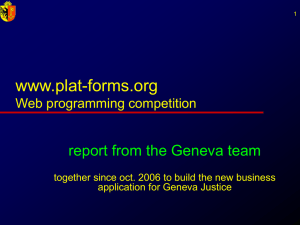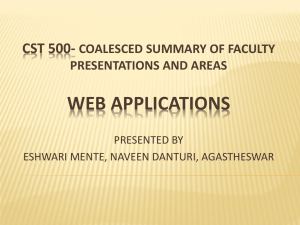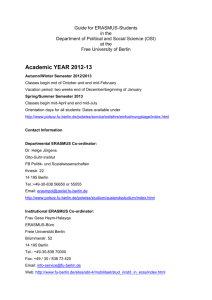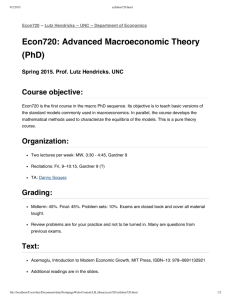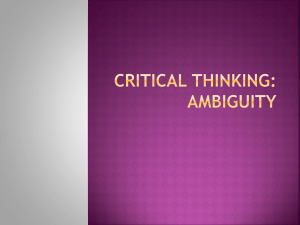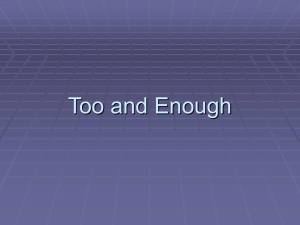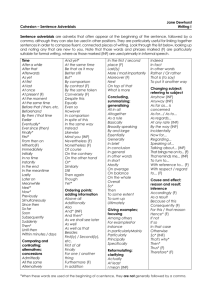Information flow in the microprocess
advertisement
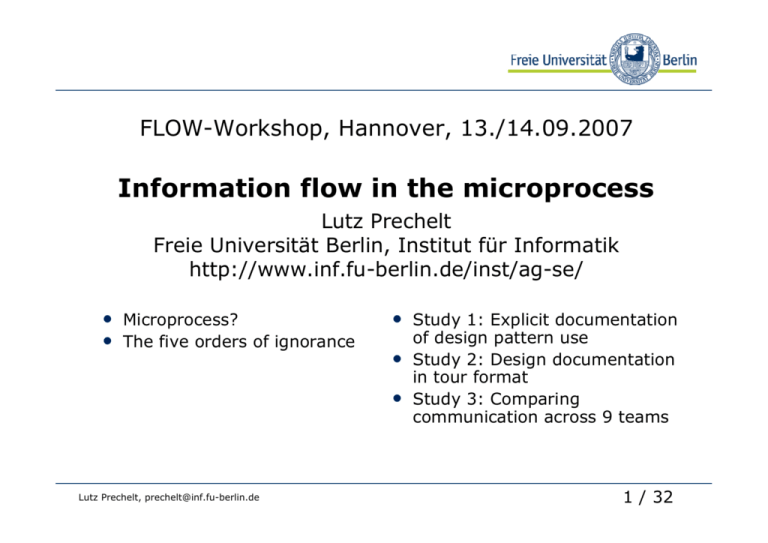
FLOW-Workshop, Hannover, 13./14.09.2007 Information flow in the microprocess Lutz Prechelt Freie Universität Berlin, Institut für Informatik http://www.inf.fu-berlin.de/inst/ag-se/ • Microprocess? • The five orders of ignorance • Study 1: Explicit documentation • • Lutz Prechelt, prechelt@inf.fu-berlin.de of design pattern use Study 2: Design documentation in tour format Study 3: Comparing communication across 9 teams 1 / 32 Microprocess: What and why? • It is known that what developers and teams really do ("actual process") is much more complex than what is described by process models • The microprocess is a close-up, fine-grained view of the development process • The basis for capturing and understanding the actual process • Microprocess activities take on the order of 1 second to a few minutes • Qualitative analysis of the microprocess also helps understand individual technologies and techniques Lutz Prechelt, prechelt@inf.fu-berlin.de 2 / 32 Results of information flow: The five orders of ignorance • Phillip G. Armour: "The Five Orders of Ignorance", CACM 43(10):17-20, October 2000 • 0th Order of Ignorance (0OI): Knowledge • I know • 1st Order of Ignorance (1OI): Lack of Knowledge • I don't know, but I know that/what I don't know • 2nd Order of Ignorance (2OI): Lack of Awareness • I don't know and I am not aware of this fact • But I do have a process for locating my knowledge gaps Lutz Prechelt, prechelt@inf.fu-berlin.de • 3rd Order of Ignorance (3OI): Lack of process • I don't know and I am not aware of this fact • And I do not have a process for locating my knowledge gaps: • I cannot determine the nature of my ignorance • 4th Order of Ignorance (4OI): Meta-Ignorance • I am not aware that 2OI or 3OI exist • 1OI vs. 2OI is a crucial difference w.r.t. information flow 3 / 32 What next? • I will present three previous studies of my group that contribute bits about information flow • Two of them concern documentation formats • One looks at actual team-level communication frequencies • No coherent whole • Interpretation is left as an exercise to the workshop Lutz Prechelt, prechelt@inf.fu-berlin.de 4 / 32 1) Explicit documentation of design pattern use in source code A controlled experiment (actually two, with some differences): • Two groups of student subjects each perform a number of understanding and modification tasks on two small programs • 6-11 classes, 362-565 LOC (including comments) • Both programs use design patterns • Program "And/Or tree": Composite pattern, Visitor pattern • Program "Phonebook": Observer method, Template Method pattern • One group receives a well-commented version of each program • 133-197 LOC are comments only • The other receives the same programs but with redundant pattern comment lines (PCL) added • An additional 10-22 lines of comments Lutz Prechelt, prechelt@inf.fu-berlin.de 5 / 32 Pattern Comment Lines (PCL) Lutz Prechelt, prechelt@inf.fu-berlin.de 6 / 32 Results (And/Or tree) • Dependent variables: • correctness of solutions according to review (measured in points) • time required (in minutes) Lutz Prechelt, prechelt@inf.fu-berlin.de 7 / 32 Interpretation • Each of the four results (2 programs, experiments UKA/Java and WUSTL/C++) supports one of the following two hypotheses: • H1: Pattern-relevant maintenance tasks will be completed faster if PCL are added • 0 to 40 percent speedup found • H2: Fewer errors will be committed in pattern-relevant maintenance tasks if PCL are added • Twice as many completely correct solutions for UKA And/Or tree • (None of the results supports both hypotheses at once) Lutz Prechelt, prechelt@inf.fu-berlin.de 8 / 32 Results and Interpretation • PCL allowed more of the slower participants to arrive at a correct solution Lutz Prechelt, prechelt@inf.fu-berlin.de 9 / 32 What is the cause of these results: PCL format or just "more comments"? • a Lutz Prechelt, prechelt@inf.fu-berlin.de 10 / 32 What is the cause of these results: PCL format or just "more comments"? Lutz Prechelt, prechelt@inf.fu-berlin.de 11 / 32 Conclusion • An attempted information flow may happen more quickly or more reliably when the information takes a suitable form • For instance one that uses known concepts (such as specific design patterns) • Explicit design pattern documentation avoids 2OI • i.e. avoids a lack of the awareness that understanding the presence of design pattern instances may be helpful Lutz Prechelt, prechelt@inf.fu-berlin.de 12 / 32 Literature • Lutz Prechelt, Barbara Unger, Michael Philippsen, Walter F. Tichy: Two Controlled Experiments Assessing the Usefulness of Design Pattern Documentation in Program Maintenance. IEEE Transactions on Software Engineering, 28(6):595-606, June 2002. Lutz Prechelt, prechelt@inf.fu-berlin.de 13 / 32 2) Design documentation in tour format A controlled experiment: • Two groups of student subjects perform a rather difficult understanding and change-planning task on a substantial program • JHotDraw: 448 classes, 27 KLOC (plus 34 KLOC of comments) • Both groups receive the same program and equivalent design documentation • But the design documentation comes in different formats • Group P: Relevant design documentation as a plain text file • Group J: Equivalent documentation embedded piecewise in the source code in in the form of tours • With tool support (JTourBus) for navigating along the tour stops • Idea: Easy access to further detail from the source code Lutz Prechelt, prechelt@inf.fu-berlin.de 14 / 32 Tour stop source code format and navigation tool (JTourBus) • JavaDoc-style annotations • interpreted by an Eclipse plugin Lutz Prechelt, prechelt@inf.fu-berlin.de 15 / 32 Result • Wrong answers and givers-up were much quicker with JTourBus (J) than with plaintext (P) Lutz Prechelt, prechelt@inf.fu-berlin.de 16 / 32 Conclusion • Providing details (complexity) closely along with design documentation makes overstrained developers recognize their problems faster • Such details-embedding converts large-scale 2OI (lack of awareness) into large-scale 1OI (lack of knowledge) • i.e. makes developers recognize how much they don't know Lutz Prechelt, prechelt@inf.fu-berlin.de 17 / 32 Literature • Christopher Oezbek, Lutz Prechelt: "JTourBus: Simplifying Program Understanding by Documentation that Provides Tours through the Source Code", 23rd IEEE Int'l. Conf. on Software Maintenance, October 2007, to appear Lutz Prechelt, prechelt@inf.fu-berlin.de 18 / 32 3) Comparing communication across 9 teams • 9 teams of 3 each build the same system in 30 hours • simple web-based community portal • 20-page specification, 150 req's • functionality prescribed precisely • complete freedom for GUI Lutz Prechelt, prechelt@inf.fu-berlin.de 19 / 32 What: "People by Temperament" Registration for community portal Lutz Prechelt, prechelt@inf.fu-berlin.de 20 / 32 What (2): Trivial Temperament Test (TTT) • After registration, members can take the TTT personality test • to determine their MBTI personality type Lutz Prechelt, prechelt@inf.fu-berlin.de 21 / 32 What (3): Search for members • Search for members by complex criteria Lutz Prechelt, prechelt@inf.fu-berlin.de 22 / 32 What (4): Member list (e.g. for search results) Lutz Prechelt, prechelt@inf.fu-berlin.de 23 / 32 What (5): Member status page Lutz Prechelt, prechelt@inf.fu-berlin.de 24 / 32 What (6): Further requirements • The above screenshots showed a solution for the 108 Web GUI requirements in addition, there were • 19 requirements regarding a SOAP webservice interface • 19 non-functional requirements • browser compatibility, performance, etc. • 5 rules describing the form of solution delivery • Each requirement was marked with priority MUST, SHOULD, or MAY Lutz Prechelt, prechelt@inf.fu-berlin.de 25 / 32 Purpose • Teams used different web development platforms • Java, Perl, PHP (3 teams each) • Plat_Forms is looking for consistent platform differences • in either process or product • Product characteristics we attempted to analyze were Completeness, ease-of-use, robustness/error-handling, security, correctness, scalability, size, structure, maintainability • For process analysis we took notes and photographs: • One activity descriptor for each team member every 15 minutes • Descriptors: thinking, reads specification, uses IDE, email, browser prototype, browser other, computer other, talk to team, talk to other, pause for food, pause other, pause&absent • Collaborative activities were marked with '2' or '3' Lutz Prechelt, prechelt@inf.fu-berlin.de 26 / 32 Example process behavior Talk team 2 Talk team 2 Read Specification 9:29 18:29 Develop 2 Develop Develop 2 Lutz Prechelt, prechelt@inf.fu-berlin.de 27 / 32 Observed communication behavior • T: Talk • d: Develop • b: Browser use 9:00 Lutz Prechelt, prechelt@inf.fu-berlin.de (2 or more people together) (2 or 3 people together) (2 or 3 people together) 1:00 9:00 15:00 28 / 32 Observations on the data • Some teams hardly co-develop (3, 5), others do it a lot (4, 8) • Some teams communicate much less (3, 7) than others (8) • Some teams have phases of intense communication (4, 6, 8), but these lie at different times 9:00 Lutz Prechelt, prechelt@inf.fu-berlin.de Inter preta 1:00 tion? 9:00 29 / 15:00 32 Conclusion? Maybe: • Oberving the frequency of information flows without observing their content is hardly helpful for understanding Lutz Prechelt, prechelt@inf.fu-berlin.de 30 / 32 Literature • Lutz Prechelt: "Plat_Forms 2007: The Web Development Platform Comparison – Evaluation and Results", Freie Universität Berlin, Institut für Informatik, Technical Report B-07-10 http://www.plat-forms.org Lutz Prechelt, prechelt@inf.fu-berlin.de 31 / 32 Thank you! Lutz Prechelt, prechelt@inf.fu-berlin.de 32 / 32 Results 1: Completeness of solutions GUI requirements Note: - Team Java 4 was hampered by a huge VMware setup problem for almost a full day - Team Java 9 used a framework still in alpha development (RAP) Lutz Prechelt, prechelt@inf.fu-berlin.de 33 / 32 Results 2: Size of solution source lines-of-code Note: Further manually written source code resides in modified reused files. Lutz Prechelt, prechelt@inf.fu-berlin.de 34 / 32 Results 3: Robustness and Security 1 test per column red: security risk reddish: broken yellow: acceptable green: OK Lutz Prechelt, prechelt@inf.fu-berlin.de 35 / 32 Results: Other • Many other aspects were compared • • • • • Ease-of-use Correctness/reliability Modifiability, solution structure Team behavior during the development process Teams' self-reported subjective experience • Some of them exhibit further platform differences • in particular often smaller variance among the PHP teams Lutz Prechelt, prechelt@inf.fu-berlin.de 36 / 32 Who: Teams • Team 3 Java: abaXX Technology (abaxx.de) • Team 4 Java: Accenture Technology Solutions (accenture.de) • Team 9 Java: Innoopract Informationssysteme (innoopract.de) • Team 1 Perl: Etat de Genève/Optaros (ge.ch, optaros.com). • Team 2 Perl: plusW (plusw.de) • Team 5 Perl: Revolution Systems (revsys.com) • Team 6 PHP: OXID eSales (oxid-esales.com) • Team 7 PHP: Globalpark (globalpark.de) • Team 8 PHP: Zend Technologies (zend.com) Lutz Prechelt, prechelt@inf.fu-berlin.de 37 / 32
